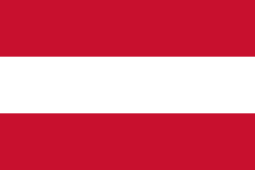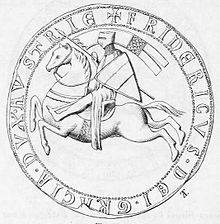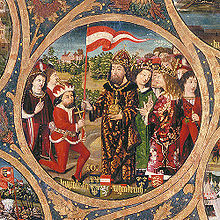Flag of Austria
 | |
| Use | Civil flag and ensign |
|---|---|
| Proportion | 2:3 |
| Adopted | 1230 (first recorded use) 1 May 1945 (formally adopted) |
| Design | A horizontal triband of red (top and bottom) and white. |
| Proportion | 2:3 |
| Design | A horizontal triband of red (top and bottom) and white defaced with the coat of arms of Austria at its centre. |
The
The Austrian flag is considered one of the
In addition to serving as the flag of Austria since 1230, it was adopted as the naval ensigns and flags of the Grand Duchy of Tuscany and Duchy of Modena and Reggio in the 18th and 19th centuries respectively, as both were ruled by cadet branches of the House of Habsburg.
History
Origins

The flag traces back to the coat of arms of the medieval
When the last Otakar Duke
The Babenberg family colours developed to the coat of arms of their Austrian possessions. After the dynasty had become extinct with Frederick's death at the 1246 Battle of the Leitha River, they were adopted by his Přemyslid successor King Ottokar II of Bohemia. Upon the 1278 Battle on the Marchfeld the colours were assumed by the victorious House of Habsburg and gradually became the coat of arms of the dynasty's Hereditary Lands within the Habsburg monarchy.
Legend

According to legend, the flag was invented by Duke Leopold V of Austria as a consequence of his fighting during the Siege of Acre. After a fierce battle, his white surcoat was completely drenched in blood. When he removed his belt, the cloth beneath remained unstained, revealing the combination of red-white-red. So taken was he by this singular sight that he adopted the colours and scheme as his banner.[2] The incident was documented as early as 1260.[citation needed]
In fact, the war flag of the Holy Roman Empire during the Crusades was a silver cross on a red field quite similar to the later Austrian arms. This sign was used by the Austrian capital Vienna from the late 13th century onwards.
Habsburg Monarchy

 Flag of the Austrian Empire (used c. 1804–1867)
Flag of the Austrian Empire (used c. 1804–1867)Since the days of
Beginning in the reign of Emperor
Austrian flag coin
The Austrian flag has been the main motif of many collector coins. One of the most recent examples is the 20 euro
Colours
The Constitution of Austria does not specify the colour shades of the flag, but members of the Austrian Armed Forces are told that the red on the coat of arms (which is used for the flag shield on the eagle) is Pantone 186 C.[4]
| Pantone | RGB | CMYK | Hexadecimal |
|---|---|---|---|
| 186 C | 200, 16, 46[5] | 0, 100, 80, 5[5] | #C8102E[5] |
The red-white-red Austrian flag is almost identical to several other flags found around the world, including the flags of
See also
- List of Austrian flags
- Flags of Austrian states
- Coat of arms of Austria
- Flag of Peru, similar design with vertical stripes
- Flag of Latvia, similar design with carmine colour instead of red and narrower white line
References
- ^ "Austria's national colors: Red-White-Red". Austrian Information. 27 (6): 7. 1974.
- ISBN 0-203-93496-2(pp. 19–20)
- ^ Volker Preuß. "National Flaggen des Österreich-Ungarn" (in German). Retrieved 2004-11-03.
- ^ "Verlautbarungsblatt I des Bundesministeriums für Landesverteidigung" (PDF) (in German).
- ^ a b c "PANTONE 186 C". Archived from the original on 2021-05-15. Retrieved 2020-06-18.
